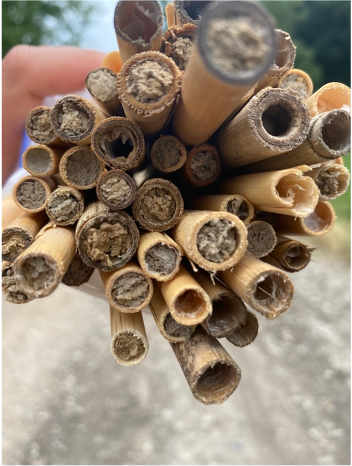BeeAInspector 
Blog 1
Hi everyone, we are Phil and Ale, and like all of you, we are interested in saving the bees and using some fun tech along the way .
About us
Phil: I am a semiconductor test engineer and my passion is using information technology to tackle real world problems. I like contributing to progress and making processes easier, safer and more reliable through innovation.
Ale: I am a biologist working at a university in plant-insect networks, such as herbivores and pollination. I am interested in sustainable development and conservation, specially in the way we do agriculture and we feed humanity.
Phil will be building up the technical set up, with Ale as a consultant on the biological aspects of the bees. We hope our interdisciplinary backgrounds help us address better the “Element 14 Save the bees” challenge and help with testing our device in the ground eventually.
For this challenge we would like to build up a camera set up that allows us to record solitary bees and a few aspects of their biology that are still understudied. In this first blog we will introduce you to the bee species we will be working with and the research questions we would like to address and to info about our model bees, that will be useful to understand our set up later. In further blog posts we will go deeper into the technical aspects.
About the solitary and wild bees
There are 22000 species of bees around the world, most of which are solitary. This doesn’t mean that they live alone; just means that they do not form part of a colony, like honeybees or bumblebees, but each of them makes a nest of its own, usually next to each other. Some of the most common types of solitary bees that nest in our region (Germany) are called Mason bees, and some examples of species are Osmia bicornis (common name: red mason bee) and Megachile centuncularis (common name: leafcutter bee).

Osmia bicornis (common name: red mason bee)
 By S.Falk (Flicker)
By S.Falk (Flicker)
Megachile centuncularis (common name: leafcutter bee)
You can see from the images how different these bees look to the european honeybee most people are familiar with. These bees don’t produce honey in their nests, but they still visit flowers for their nectar and pollen.
Fun fact!
Mason bees collect pollen in their bellies (called the abdominal scopa), instead of carrying it in their legs. Pollen is very important for the larvae of the bee, because it contains the proteins necessary to develop.
In honeybee colonies, there is only one bee that mates and lays eggs – the queen. But for mason bees, all females bees can mate and build a nest of their own, starting in spring. In a reed or hollow branch they lay multiple eggs in a row, each in one compartment that they close off with soil or pieces of leaves. Each reed can have approximately 4-12 cells, from which usually the female (eggs) are lay first (at the bottom) since they take longer to develop than the male (eggs) that go in front (towards the exit of the reed).

Opened reed from a red mason bee: you can see 5 cells, each with a an egg and pollen reserve, separated by a wall made with soil (as are the safety and exit closures)
The mother bee also patiently brings pollen grains into each cell so the larvae can feed while it grows and transforms into a pupae. The exit of the reed is sealed with soil or leaves, depending on the species, to prevent parasites and other bees from entering and disturbing the nest.
A lot of work goes into building a nest! And a mother bee only can do a handful until their time is up and they die, which depending on the species would be around end of summer or autumn.

Closed and opened reeds from a red mason bee from outside
Our research questions
Most research is being done in honeybees, given their importance for honey production and pollination of crops, whereas less is known of the biology of solitary bees, even if they a crucial part of pollination services for crops and wild plants. Wild bees can in many cases even be more efficient in pollination than honeybees because they sometimes specialize in only one type of plant (a well known case being the alfalfa crop).
In the context of conservation of solitary bees, it would be important to be able to explore:
How long does it take for a wild bee nest to fill up?
How many flights does the mother bee makes to bring in pollen to the larvae before closing the nest?
How is the temperature, air quality and humidity level affecting the proportion of reeds successfully filled and closed?
The challenge: BeeAInspector
Answering these questions requires that naturalists and scientist spend many hours recording observations during long periods of time, often months. Also many of these nests need to be placed where the wild bees are, which can be anything from easy access balconies and patios in urban spaces to difficult access faraway areas in national parks and agricultural fields. So scientists spend a lot of time, resources and effort traveling to these areas multiple times, and even so they cannot monitor every nest at the same time.
Camera traps can be a useful tool to better understand life cycles and correlate developmental milestones with environmental factors that affect them. An intelligent camera could provide a daily record of bee movement in without a person being present on site. Furthermore, if it would be paired with sensors that measure different environmental parameters, these could be correlated with the bee movements and percentage of filled nests. Finally, we could develop software to analyze the images over time and inform about the ratio of filled vs. empty reeds.
This is what we want to achieve with BeeAInspector, a project that with a playful name between bees, AI, and inspection will basically be a camera trap to help in wild bee conservation and research.
In further blog posts, we will dig deeper into the technical aspects of this project. We do hope the kits arrives soon! Hope you enjoyed our first blog and feel free to ask questions in the comment section
Phil and Ale


